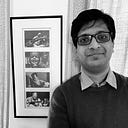Pratapavarali — the big adventure of a little raga.
Such a long journey
27-minute grandeur
At the recent Cross Roads festival organized by First Edition Arts in Manipal, leading sarod artiste Prattyush Banerjee played the raga Pratap Varali for close to half an hour. He was accompanied by tabla stalwart Swapan Chaudhuri. Prattyush Banerjee is a disciple of the late Buddhadev Dasgupta of the Senia-Shahjahanpur gharana. Listen in:
A ditty
Pratapavarali is in fact a raga from the Carnatic music tradition, and a very minor raga at that. It is more scale than fully-formed raga. It has a selection of notes of Harikambhoji (equivalent to the Khamaaj thaat in Hindustani music). The notes in ascent and descent are SRGMPDPS — SDPMGRS.
As with many such jaunty scale-based ragas, the most well-known song is that of the great composer Thyagaraja — Vina naa Asakoni. It’s a breezy little song. Here are a few renditions:
In keeping with the ‘lightness’ of the raga, the theme of the song is also playful and circumscribed. Rama and Sita play a game — the winner gets to tie up the loser. Sita wins but doesn’t have the heart to go through with the reward / punishment, and so ‘ties’ him up with a garland of flowers instead. Thyagaraja wishes he had been there to witness the scene.
To Mumbai via Mysuru
Another even more rarely heard song in the raga is Bhoori Bhagya Lahari composed by Maharaja Jayachamarajendra Wodeyar. You can hear the ‘raga mudra’ (Pratapavali) incorporated into the charanam (last part) of the song:
One of the few renditions of the Hindustani Pratap Varali that I found on Youtube was by Anuradha Kuber of the Bhendi Bazaar gharana:
It makes sense that the artiste is from the Bhendi Bazaar gharana. This is a relatively small and recent gharana (dating from the late decades of the 19th century), and unique in that it is named after locality right in the middle of a bustling metro — Mumbai. It is known for importing several Carnatic ragas into Hindustani music.
The protagonist of this experiment was Ustad Aman Ali Khan who spent many years in the Mysore Wodeyar court, was greatly influenced by Carnatic stalwarts he met there, like Bidaram Krishnappa, and studied the art form keenly. He is the author of the bandish ‘Lagi Lagan Pati Sakhi Sang’ which is synonymous with the raga Hamsadhwani in the Hindustani tradition and is a melodic + syllabic transcription of the first line of Muthuswami Dikshitar’s ‘Vathapi Ganapathim Bhajeham’ in the same raga. Not coincidentally, ‘Pati’ in the former and ‘pathim’ in the latter coincide perfectly. Apart from taking Carnatic ragas with him he also took along the heavy Carnatic use of ‘sargam’ / solfa-syllables, one of the defining features of the Bhendi Bazaar Gharana.
Homecoming
So there we have it — the long journey of a little raga. Starting off as not much more than a playful ditty in the hands of Thyagaraja. Gestating in the Mysore palace. Carried on to a Mumbai gharana by the capable Aman Ali Khan. Studied and assimilated by a beenkar tradition in another great metropolis. And then brought back in all its relaxed glory for an audience in Manipal, not too far from Mysore. A grand odyssey of over 5,700 kilometers!
Postscripts
A post on ‘scale-based’ ragas and whether they can grow up to be ‘fully-fledged’:
And another on Carnatic and Hindustani cross currents of sorts:
In my view, the Pratapavarali — Pratap Varali transmorgification experiment is a success. Other such attempts to assimilate Carnatic ragas into Hindustani music have not been as successful, at least to my Carnatic ear. For instance, take this rendition of the very popular Carnatic raga Arabhi, by Vidushi Ashwini Bhide Deshpande:
The difference between Pratapavarali and Arabhi is that the identity of Arabhi lies in its gamakas and prayogas — how the notes are handled and how they interact with each other, rather than simply the scale. So when the scale (SRMPDS — SNDPMGRS) is taken and stripped off its Carnatic embellishments for adoption as a gamaka-free Hindustani raga, it sounds ‘off’. I truly appreciate the open-mindedness and seeking nature of the artistes who undertake such experiments. But I would urge that they choose ‘scale-based’ Carnatic ragas for adoption into Hindustani music, or if adopting the scale of a rich raga like Arabhi, then to rename it so it can be experienced by the likes of me afresh, without any preconceptions to detract from a potentially beautiful experience in its own right.
